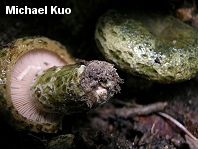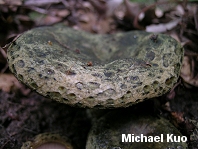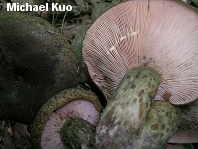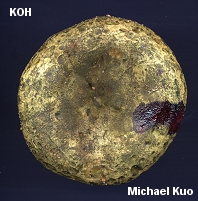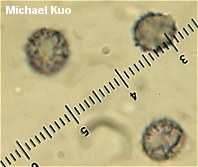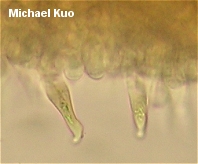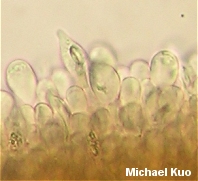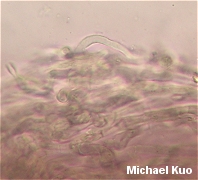| Major Groups > Gilled Mushrooms > Pale-Spored > Lactarius > Lactarius atroviridis |

|
Lactarius atroviridis [ Agaricomycetes > Russulales > Russulaceae > Lactarius . . . ] by Michael Kuo There is no mistaking this species. The spotted green surface of the cap and stem, the pale pinkish gills, and the creamy white milk make it one of the most distinctive mushrooms I've ever seen. Lactarius atroviridis is partial to oaks, and is widely distributed east of the Great Plains. Lactarius atroviridis is quite variable in some of its features, including the color of the milk, the taste, the size and shape of the spores, and the anatomy of its macrocystidia and pileipellis. Given the wide geographic range of the species, perhaps more than one species is involved. Description: Ecology: Mycorrhizal with oaks (but sometimes reported under conifers); growing alone or gregariously; summer and fall; widely distributed east of the Mississippi River, with a range extending at least as far south as Costa Rica. Cap: 3-15 cm; convex becoming planoconvex with a central depression; dry, or sticky in wet weather; pock-marked and rugged, sometimes smoother over the disc; various shades of green, often with darker green spots arranged concentrically over the marginal half; the margin inrolled. Gills: Attached or beginning to run down the stem; close; pale pinkish; often bruising and staining greenish to brownish; frequently with green tints on the edges of mature gills; short-gills frequent. Stem: 2-8 cm long; 1-2.5 cm thick; equal or tapering to the base; slimy when fresh, but soon dry; with many potholes; colored and textured like the cap; becoming hollow with age. Flesh: Whitish to pale pinkish. Milk: Fairly copious; creamy white; sometimes becoming greenish on exposure to air. Odor and Taste: Odor not distinctive; taste acrid, according to the literature, but also quite mild in my collecting experience. Chemical Reactions: Cap surface dark purple-magenta with KOH. Spore Print: Cream. Microscopic Features: Spores 6-9 x 5.5-6.5 µ; subglobose to broadly ellipsoid; ornamentation 0.2-1.0 µ high, as amyloid warts and ridges forming broken or partial reticula. Pleuromacrocystidia absent, scattered, or fairly abundant; clavate to fusiform; not projecting, or up to 100 µ long. Cheilomacrocystidia similar; scattered to abundant. Pileipellis a cutis to an ixocutis; elements pink in KOH. REFERENCES: Peck, 1889. (Saccardo, 1891; Coker, 1918; Kauffman, 1918; Hesler & Smith, 1979; Smith, Smith & Weber, 1979; Weber & Smith, 1985; Phillips, 1991/2005; Binion et al., 2008; Kuo & Methven, 2010.) Herb. Kuo 07240403, 07210706. This site contains no information about the edibility or toxicity of mushrooms. |
© MushroomExpert.Com |
|
Cite this page as: Kuo, M. (2011, March). Lactarius atroviridis. Retrieved from the MushroomExpert.Com Web site: http://www.mushroomexpert.com/lactarius_atroviridis.html |
